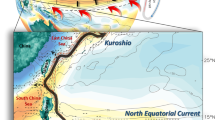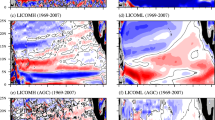Abstract
An ocean circulation model is run using two different idealized equatorial basin configurations under steady wind forcing. Both model versions produce bands of vertically alternating zonal flow at depth, similar to observed Equatorial Deep Jets (EDJs) and with a time scale corresponding to that of the gravest equatorial basin mode for the dominant baroclinic vertical normal mode. Both model runs show evidence for enhanced variability in the surface signature of the North Equatorial Counter Current (NECC) with the same time scale. We also find the same link between the observed NECC and the EDJs in the Atlantic by comparing the signature of the EDJ in moored zonal velocity data at 23° W on the equator with the signature of the NECC in geostrophic velocities from altimeter data. We argue that the presence of a peak in variability in the NECC associated with the EDJ basin mode period is evidence that the influenceatthis time scale is upward, from the EDJ to the NECC.










Similar content being viewed by others
Notes
It should be noted that because of the inverse dependence on vertical wavenumber in the dispersion relation for linear equatorial waves (Gill 1982), vertical energy propagation, given by the group velocity, is always in the opposite direction to the vertical component of the phase velocity.
References
Ascani F, Firing E, McCreary JP, Brandt P, Greatbatch RJ (2015) The deep equatorial ocean circulation in wind-forced numerical solutions. J Phys Oceanogr. doi:10.1175/JPO-D-14-0171.1
Brandt P, Funk A, Hormann V, Dengler M, Greatbatch RJ, Toole JM (2011) Interannual atmospheric variability forced by the deep equatorial Atlantic Ocean. Nature 473(7348):497–500
Brandt P, Greatbatch RJ, Claus M, Didwischus S-H, Hormann V, Funk A, Hahn J, Krahmann G, Fischer J, Körtzinger A (2012) Ventilation of the equatorial Atlantic by the equatorial deep jets. J Geophys Res 117(C12):C12015
Brown G, Sutherland B (2007) Internal wave tunnelling through non-uniformly stratified shear flow. Atmosphere-Ocean 45(1):47–56
Cane M, Moore D (1981) A note on low-frequency equatorial basin modes. J Phys Oceanogr 11:1578–1584
D’Orgeville M, Hua B, Sasaki H (2007) Equatorial deep jets triggered by a large vertical scale variability within the western boundary layer. J Mar Res 65(1):1–25
Eden C, Dengler M (2008) Stacked jets in the deep equatorial Atlantic Ocean. J Geophys Res 113(C4):1–12
Eriksen C (1982) Geostrophic equatorial deep jets. J Geophys Res 40:143–157
Gill AE (1982) Atmosphere-ocean dynamics, international geophysics. Elsevier Science. https://books.google.de/books?id=8kFPh_SvnAIC
Hormann V, Lumpkin R, Foltz GR (2012) Interannual north equatorial countercurrent variability and its relation to tropical Atlantic climate modes. J Geophys Res 117(C4):C04035
Hua BL, D’Orgeville M, Fruman MD, Menesguen C, Schopp R, Klein P, Sasaki H (2008) Destabilization of mixed Rossby gravity waves and the formation of equatorial zonal jets Vol. 610
Johnson G, Kunze E (2002) Temporal and spatial structure of the equatorial deep jets in the pacific ocean∗. J Phys Oceanogr 32
Kalnay E, Kanamitsu M (1996) The NCEP/NCAR 40-year reanalysis project. Bulletin of the American Meteorological Society
Lagerloef GSE, Mitchum GT, Lukas RB, Niiler PP (1999) Tropical Pacific near-surface currents estimated from altimeter, wind, and drifter data. J Geophys Res 104:23,313–23,326
Leetmaa A, Spain PF (1981) Results from a velocity transect along the equator from 125 to 159W. J Phys Oceanogr 11:1030–1033
Levitus S (1983) Climatological atlas of the world ocean, Eos, Transactions American Geophysical Union
Luyten JR, Swallow J (1976) Equatorial undercurrents. Deep Sea Research and Oceanographic Abstracts 23(10):999–1001
Marshall J, Hill C, Perelman L, Adcroft A (1997) Hydrostatic, quasi-hydrostatic, and nonhydrostatic ocean modeling. J Geophys Res 102(C3):5733–5752
Pacanowski R, Philander S (1981) Parameterization of vertical mixing in numerical models of tropical oceans. J Phys Oceanogr 11:1443–1451
Acknowledgments
This study has been supported by the Deutsche Forschungsgesellschaft as part of the Sonderforschungsbereich 754 “Climate Biogeochemistry Interactions in the Tropical Oceans.” We are also grateful for support from the European Union 7th Framework Programme (FP7 20072013) under grant agreement 603521 PREFACE Project and the BMBF SACUS (03G0837A)project, as well as continuing support from GEOMAR. The altimeter products were produced by Ssalto/Duacs and distributed by AVISO, with support from CNES http://www.aviso.altimetry.fr/duacs/. NCEP reanalysis data were provided by the NOAA/OAR/ESRL PSD, Boulder, Colorado, USA, from their website at http://www.esrl.noaa.gov/psd/. We are grateful to François Ascani for his help with the model setup and ongoing discussions on the topic of equatorial deep jets and their representation in models, and also to two anonymous reviewers and the editor for helpful comments.
Author information
Authors and Affiliations
Corresponding author
Additional information
Responsible Editor: Chris Wilson
This article is part of the Topical Collection on Atmosphere and Ocean Dynamics: A Scientific Workshop to Celebrate Professor Dr. Richard Greatbatch’s 60th Birthday, Liverpool, UK, 10-11 April 2014
Appendix
Appendix
The spectra in Figs. 5b, 8a, and 9a are derived first by computing the modulus of the Fourier transform, \(\hat {u}_{\omega ,x,y,z}\), of the zonal velocity, u t,x,y,z , for each frequency ω and at each grid point inside the respective boxes; these boxes are a surface box (referred to in the figure captions) and a deep box extending from 450 to 550 m depth at a location on the equator near the center of the basin (45° from the western boundary for model A and 30° for model B). The spectra shown in the figures are then computed by averaging these moduli over the respective boxes.
To estimate the significance of the peaks in the spectra, we first extract a subsample of the time series in u t,x,y,z . The reason for using a subsample is to take account of the reduction in the number of degrees of freedom arising from the autocorrelation of the time series. We then construct random permutations of the subsampled time series using the same permutation at each grid point within each box. Using the same permutation at each grid box preserves the covariance in the x, y, and z directions within each box. For each realization the mean spectrum in the boxes is then computed in the same way as for the original time series. This ensures that the randomly generated spectra have the same number of degrees of freedom in the boxes as the original spectra. To arrive at a significance level, the original spectra are compared to the 90th percentile of the randomly generated spectra. Then, 10,000 different permutations are used and for each frequency, the amplitude at which 9000 realizations have a lower amplitude defines the 90th percentile, where amplitude here refers to the average of the moduli of the Fourier transforms within each box. A peak in the original spectrum is then significant at the 90 % level if the amplitude at that frequency exceeds the 90th percent percentile.
Rights and permissions
About this article
Cite this article
Matthießen, JD., Greatbatch, R.J., Brandt, P. et al. Influence of the equatorial deep jets on the north equatorial countercurrent. Ocean Dynamics 65, 1095–1102 (2015). https://doi.org/10.1007/s10236-015-0855-5
Received:
Accepted:
Published:
Issue Date:
DOI: https://doi.org/10.1007/s10236-015-0855-5




